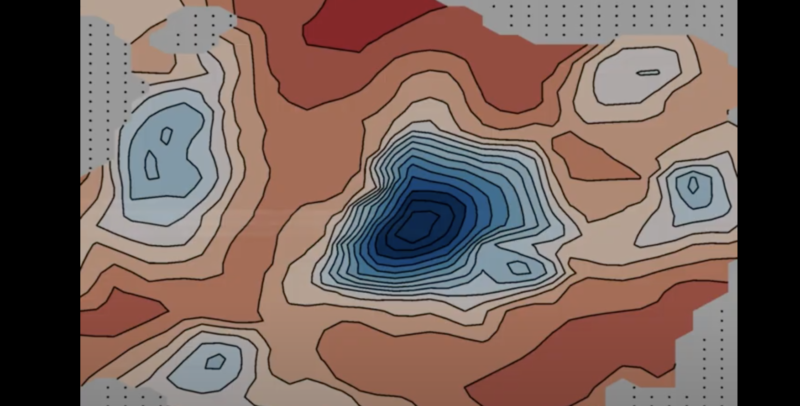Salt on the rocks —
It can be tough to spot water under an ice cap from orbit.
John Timmer
–

In recent decades, we’ve become aware of lots of water on Earth that’s deep under ice. In some cases, we’ve watched this water nervously, as it’s deep underneath ice sheets, where it could lubricate the sheets’ slide into the sea. But we’ve also discovered lakes that have been trapped under ice near the poles, possibly for millions of years, raising the prospect that they could harbor ancient ecosystems.
Now, researchers are applying some of the same techniques that we’ve used to find those under-ice lakes to data from Mars. And the results support an earlier claim that there are bodies of water trapped under the polar ice of the red planet.
Spotting liquids from orbit
Mars clearly has extensive water locked away in the form of ice, and some of it cycles through the atmosphere as orbital cycles make one pole or the other a bit warmer. But there’s not going to be pure liquid water on Mars—the temperatures just aren’t high enough for very long, and the atmospheric pressures are far too low to keep any liquid water from boiling off into the atmosphere.
Calculations suggest, however, that liquid water is possible on Mars—just not on the surface. With enough dissolved salts, a water-rich brine could remain liquid at the temperatures prevalent on Mars—even in the polar areas. And if it’s trapped under the Martian surface, there might be enough pressure to keep it liquid despite the thin atmosphere. That surface could be Martian soil, and people are thinking about that possibility. But the surface could also be one of the ice sheets we’ve spotted on Mars.
That possibility helped motivate the design of the MARSIS (Mars Advanced Radar for Subsurface and Ionosphere Sounding) on the Mars Express orbiter. MARSIS is a radar device that uses wavelengths that water ice is transparent to. As a result, most of the photons that come back to the instrument are reflected by the interface between ice and something else: the atmosphere, the underlying bedrock, and potentially any interface between the ice and a liquid brine underneath it.
And that’s what the original results, published in 2018, seemed to indicate. In an area called Ultimi Scopuli near Mars’ south pole. The researchers saw a bright reflection, distinct from the one caused by the underlying bedrock, at some specific locations under the ice. And they interpreted this as indicating a boundary between ice and some liquid brines.
Now with more data
Two things have changed since those earlier results were done. One is that Mars Express has continued to pass over Mars’ polar regions, generating even more data for analysis. The second is that studies of ice-covered lakes on Earth have also advanced, with new ones identified from orbit using similar data. So some of the team behind the original work decided it was time to revisit the ice sheets at Ultimi Scopuli.
The analysis involves looking at details of the photons reflected back to the MARSIS instrument from a 250 x 300 square kilometer area. One aspect of that is the basic reflectivity of the different layers that can be discerned from the data. Other aspects of the signal can tell us about how smooth the surface of the reflective boundaries are and whether the nature of the boundary changes suddenly.
For example, the transition from an ice-bedrock boundary to an ice-brine one would cause a sudden shift from a relatively weak, uneven signal to a brighter and smoother one.
The researchers generated separate maps of the intensity and the smoothness of the signal and found that the maps largely overlapped, giving them confidence that they were identifying real transitions in the surfaces. A separate measure of the material (called permittivity) showed that it was high in the same location.
Overall, the researchers found that the largest area that’s likely to have water under the ice as about 20 by 30 kilometers. And it’s separated by bedrock features from a number of similar but smaller bodies. Calling these bodies “lakes” is speculative, given that we have no idea how deep they are. But the data certainly is consistent with some sort of under-ice feature—even if we use the standards of detection that have been used for under-ice lakes on Earth.
How did that get there?
The obvious question following the assumption that these bodies are filled with a watery brine is how that much liquid ended up there. We know that these salty solutions can stay liquid at temperatures far below the freezing point. But the conditions on Mars are such that most of minimum temperatures for water to remain liquid are right at the edge of the possible conditions at the site of the polar ice sheets. So some people have suggested geological activity as a possible source of heat to keep things liquid.
That’s not necessarily as unlikely as it may sound. Some groups have proposed that some features indicate that there was magma on the surface of Mars as recently as 2 million years ago. But the researchers here argue that if things are on the edge of working under current climate conditions, there’s no need to resort to anything exceptional.
Instead, they suggest that the sorts of salts we already know are present on Mars can absorb water vapor out of the thin Martian atmosphere. Once formed, these can remain liquid down to 150 Kelvin, when the local temperatures at Ultimi Scopuli are likely to be in the area of 160 Kelvin and increase with depth.
And if that’s true, there could be liquid in many more locations at Mars’ poles. Not all of them are as amenable to orbital imaging as Ultimi Scopuli, but it’s a safe bet that this team will try to find additional ones.
Nature Astronomy, 2020. DOI: 10.1038/s41550-020-1200-6 (About DOIs).

